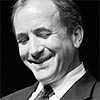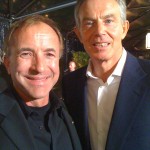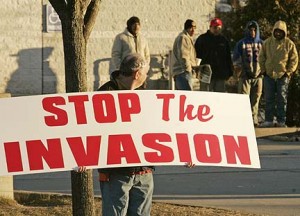Skepticblog
About Michael Shermer

Dr. Michael Shermer is the Founding Publisher of Skeptic magazine, the monthly "Skeptic" columnist for Scientific American, and author of Why people Believe Weird Things, an exploration into a variety of strange ideas, groups and cults. A psychologist, professor and historian of science, Dr. Shermer was also the co-producer and co-host of the Fox Family television series, Exploring the Unknown. Dr. Shermer has made countless appearances on television including, Oprah, Larry King Live, The Colbert Report, Dateline, 20/20, The History Channel, A&E, The Discovery Channel, and PBS as a skeptic of weird and extraordinary claims.
RSS feed for this authorwww.michaelshermer.com
www.skeptic.com
Subjects
aliens alternative medicine atheism autism belief bigfoot Brian Dunning CAM Carl Sagan climate change conspiracy theories Creation creationism critical thinking cryptozoology denialism dinosaurs Dr. Kiki earthquakes economics education environment ethics evolution fossils geology Ghost Hunting ghosts global warming God homeopathy intelligent design james randi journalism media medicine michael shermer morality nasa paleontology paranormal politics pseudoscience Psychics psychology religion science science denialism scope SETI Shermer skeptical history skepticism skeptoid Skeptologists TV ufo ufos vaccines videoRecent Comments
- Daniel Loxton commented on A Fond Farewell to Skepticblog at 1:25 pm, September 18, 2014
- markx commented on A Fond Farewell to Skepticblog at 8:52 pm, September 17, 2014
- Thomas commented on False Equivalence at 11:44 am, September 15, 2014
- John Greg commented on A Fond Farewell to Skepticblog at 2:10 pm, September 13, 2014
- tmac57 commented on A Fond Farewell to Skepticblog at 10:39 am, September 13, 2014
Read posts by author:
‘I didn’t know the mic was on’: Public Talk v. Private Talk
The recent flap over the inopportune comments by General Stanley McChrystal and his staff in the presence of and even directly to a Rolling Stone magazine journalist, and the ensuing hue and cry “off with their heads” for what amounts to something akin to alcohol-fueled barroom B.S.ing and locker-room boys-will-be-boys jock talk, affords an opportunity to distinguish between public talk and private talk.

Private talk is what we say in private to our spouses, family, friends, and colleagues when there is a presumption of privacy such that one’s comments will not go public. Public talk is what we say when we want to make a formal statement or declaration with the intention of and responsibility for what was said. Too often we confuse these two very different forms of expression. Everyone is treating the private talk of McChrystal and his staff as if it were intended for public consumption. It is almost as if McChrystal had held a press conference and issued a formal public statement that Joe Biden’s new name is “bite me.” Surely we should recognize the vast gulf that exists between these two types of talk, and no one would want to insist that all private talk be held as if there were a microphone in the room that was on and broadcasting. Locker rooms and barrooms would go deadly silent. (continue reading…)
comments (35)The Pattern Behind Self Deception
Last week I blogged about lying: “Everyone Lies: Why?”
Deception is one thing, self deception is quite another. This week TED.com has posted my new TED talk, delivered at the last TED conference, in which I present material from my forthcoming book on the neuroscience of belief, tentatively entitled The Believing Brain, a central theme of which is how we are so easily deceived and how we deceive ourselves. Here is a brief summary of the thesis of the talk, although because it is so visual I strongly recommend watching the TED video.
comments (37)Tony Blair’s Answer
The Force of Ideas Over the Force of Arms

Shermer and Tony Blair
Last week I attended the Khosla Ventures summit at Cavello Point in Sausalito, California, an ex-army base converted to a posh resort, where the venture capitalist (he calls himself a “venture assistant”) Vinod Khosla brings together start-up CEOs and their venture backers who are together innovating new science and technologies for alternative and environmentally efficient energy sources. Vinod heard my TED talk in Long Beach in February 2010 (to be posted at TED.com in June) and invited me to explain why people believe weird things about money (“The Mind of the Market”, based on my book of the same title). Vinod hosted a fireside chat with Bill Gates and Tony Blair, and in the Q & A I raised my hand and asked Tony a question. By way of background… (continue reading…)
comments (57)The Rules of Capitalism, Part 3
Liberty and The Man Who Shot Liberty Valance.
This is the third essay in a series on the relationship between rules, freedom, and prosperity.
Read part 1 on Skepticblog.org and part 2 over at True/Slant.

I believe that the following commentary on the necessity of law and order has some bearing on what is unfolding in Arizona—when the rules are not clearly written or consistently enforced, people will take the law into their own hands because society cannot run smoothly without law and order.
In Part 3 in my essay series on the relationship between rules, freedom, and prosperity, I want to turn to one of my favorite films, John Ford’s 1962 classic, The Man Who Shot Liberty Valance, in which a clash of moralities unfolds in the wild-west frontier town of Shinbone, Arizona. There in the dusty streets and ramshackle buildings two self-contained and self-consistent moral codes come into conflict. One moral code is the Cowboy Ethic, where trust is established through courage, loyalty, and personal allegiance to friends and family, and where disputes are settled and justice is served between individuals who have taken the law into their own hands. The other moral code is the Law Ethic, where trust is established through the transparent and mutually-agreed upon rule of law, and where disputes are settled and justice is served between all members of the society who, by virtue of living there, have tacitly agreed to obey the rules. Only one of these moral codes can prevail. (continue reading…)
comments (60)Good Rules Make Good Capitalists, Part 1
As the SEC prepares its case against Goldman Sachs for allegedly intentionally defrauding the public with toxic securities that it created, sold, then bet against, I want to reflect for a moment on the need for rules in a free market society. Critics of capitalism believe that we libertarians want an essentially lawless society in which people are free to do whatever they want. That may be true for some libertarians, but I have come to believe through experience and science that free markets operate best within a system of clearly defined and strictly enforced rules and laws. Within the system itself markets should be as free as possible and people should be free to trade with whomever they want without interference from the state (think Chinese citizens trading ideas about democracy with each other and outsiders), but good rules make good capitalists.
Consider a sports analogy: In 1982, three other men and I founded the 3,000-mile nonstop transcontinental bicycle Race Across America (RAAM) from L.A. to New York, sponsored by Budweiser and televised on ABC’s Wide World of Sports. The rules were simple: each cyclist takes the same route, has a support vehicle and crew that follows behind providing food, drink, and equipment, and no drafting behind or hanging onto a vehicle is allowed. The race started on the Santa Monica Pier in California. The first cyclist to reach the Empire State Building in New York City would be declared the winner. That was the entire set of rules, which we didn’t even bother to write down. (continue reading…)
comments (44)Why We Are Hardwired for Belief in God
On April 10 the Wall Street Journal published a debate between myself and Gregory Paul on the question of whether or not belief in God is innate. Here are the links to the two articles:
http://tinyurl.com/y8n7qg6
http://tinyurl.com/y52ckwf
The online version was well edited but shorter than my original draft, which I present here just for the record. Enjoy.

According to Oxford University Press’s World Christian Encyclopedia, 84 percent of the world’s population belongs to some form of organized religion, which at the end of 2009 equals 5.7 billion people who belong to about 10,000 distinct religions, each one of which may be further subdivided and classified. Christians, for example, may be aportioned among 33,820 different denominations.1 Among the many bionomial designations granted our species (Homo sapiens, Homo ludens, Homo economicus), a strong case could be made for Homo religiosus. And Americans are among the most religious members of the species. In a 2007 Pew Forum survey of over 35,000 Americans, the following percentages of belief were found: (continue reading…)
comments (76)Would I Ever Pray for a Miracle?
Watch ABC 20/20 Special on Miracles to Find Out…

Elizabeth Vargas hosts 20/20 special on miracles
Last night ABC 20/20 aired a one-hour special on miracles (such topics are common faire on television during Christmas and Easter week) hosted by Elizabeth Vargas, this one featuring the usual array of “unexplained” recoveries from injury and disease, in this case a brain injury, cancer, and Parkinson’s disease. (See my interview segments at 26:34, 28:35, 38:15, 39:05.) The producers called me on Wednesday and asked for a skeptical perspective, outlining for me the details of the stories. It was good to know the details, but it doesn’t really matter what they are because the explanation follows no matter the specifics, because of the statistical analysis I provided applies to all such cases. (continue reading…)
comments (56)Does the moon exist if there are no sentient beings to look at it?
In my last True/Slant post I explained why it is that quantum effects do not apply to the macro world because of the size difference between sub-atomic particles and (say) chemical reactions inside the neurons in your head, concluding:
During the debate Deepak claimed that the moon is nothing more than a soup of teaming quantum uncertainty. No. Subatomic particles may be altered when they are observed, but the moon is there even if no one looks at it.
Deepak wrote a thoughtful response to this blog (on his Blackberry while running on a treadmill with his agile thumbs no less!): (continue reading…)
comments (131)Pentagon Gunman a Conspiracy Theorist & 9/11 Truther
What’s the harm in believing nonsense? I get asked this all the time: “Oh come on Shermer, let people have their delusions, what’s the harm?”
I have a laundry list of retorts to this challenge, from the value of living in a rational world that is based in reality to tales of people who have died from discredited medical practices, such as “Attachment Therapy” — in April, 2000, 10-year old Candace Newmaker was smothered to death in blankets by therapists who were helping “rebirth” her so that she could properly attach to her adopted parents. Death by theory. (I wrote about this in Scientific American.)
What’s the harm? Ask the victims of the anti-Government nutter Joseph Stack, who flew his plane into the IRS building in Austin, Texas. It is one thing to be skeptical of excessive government intervention into private lives and businesses, it is quite another to take matters into your own hands, especially if those hands hold a gun. (continue reading…)
comments (182)Hosted by Skeptic magazine. For website-related matters, contact the webmaster.

The Tour de France is underway and it is already shaping up to be one of the grandest and most epic races in the event’s century-long history. If you haven’t seen a stage yet be sure to tune into the Versus Network that covers it every day, with repeat airings all day and evening. Lance is still in contention even after several crashes. In fact, I’ve never seen so many crashes in a Tour before. This event is so hard it is not surprising that, as usual, allegations and suspicions of doping have surrounded the race even before it began. Unfortunately, it appears that doping has long been a part of this — and many other — sports. Here is my explanation for why athletes in general and cyclists (my sport) in particular dope, why race organizations have such a hard time enforcing the rules, and what can be done about it.
In criminal organizations such as the Cosa Nostra in 19th century Sicily and the Mafia in 20th century southern Italy, the “omerta rule” is the code of silence, a tacit agreement among cohort members that the collective violation of the law means if you get caught you keep your mouth shut and under no circumstances cooperate with the authorities. The penalty for an omerta betrayal is ultimate and final — death. (continue reading…)
comments (66)